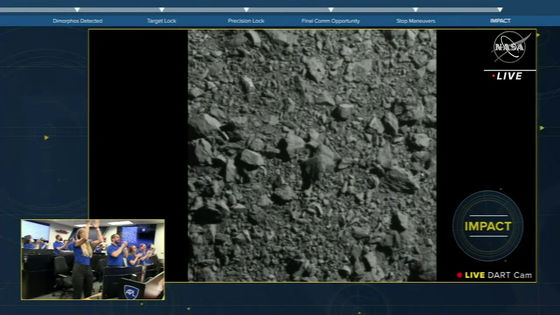NASA's ``Experiment to shift the orbit by hitting the spacecraft against the asteroid'' succeeded, and the image of the asteroid captured by the spacecraft just before the collision

In order to establish a technology to shift the orbit of asteroids and comets that fly to the earth,
NASA just redirected an asteroid by smashing a spacecraft into it | Live Science
https://www.livescience.com/dart-smashes-into-dimorphos-asteroid
A NASA Spacecraft Is About to Collide With an Asteroid. Watch Live Here : ScienceAlert
https://www.sciencealert.com/a-nasa-spacecraft-will-collide-with-an-asteroid-on-monday-watch-live-here
NASA Live Updates: DART Makes Contact With the Asteroid Dimorphos - The New York Times
https://www.nytimes.com/live/2022/09/26/science/nasa-dart-asteroid-mission
Watch Live as NASA Deliberately Crashes a Spacecraft Into Asteroid Dimorphos - CNET
https://www.cnet.com/science/space/watch-live-as-nasa-deliberately-crashes-a-spacecraft-into-asteroid-dimorphos/
The world's first mission to shift these orbits by hitting a spacecraft against an asteroid or comet is 'DART'is. DART is a mission that NASA is proceeding with the Johns Hopkins University Applied Physics Laboratory, and the target is the celestial body called ' Didymos ', a double asteroid. Didymos consists of a pair of Didymos A with a diameter of 780 meters and Didymos B with a diameter of 160 meters circling around it. DART is considered to be a demonstration in 'shifting the orbit of a dangerous celestial body that may come to Earth in the future'.
NASA will conduct a verification experiment in 2022 on how to protect the earth by colliding a spacecraft with an asteroid approaching the earth - GIGAZINE

Then, at 19:14 on Monday, September 26, 2022, local time, the spacecraft called DART, which was launched as part of the mission, collided with Dimorphos and succeeded in deflecting it from the planned orbit. The launched DART weighs 1210 pounds (about 550 kg) and is equipped with sensors, antennas, ion thrusters, and two solar arrays of 28 feet (about 8.5 meters). Dimorphos at the time of the collision seems to have been moving at a speed of 21,160 km / h.
You can see the video just before DART collided with Dimorphos from around 1 hour and 4 minutes in the following video. The collision occurred around 1 hour 16 minutes 24 seconds, and you can also check the state of NASA's control room, which is excited about the success of the mission.
DART's Impact with Asteroid Dimorphos (Official NASA Broadcast)-YouTube
Dimorphos captured by Didymos Reconnaissance and Asteroid Camera for Optical Navigation (DRACO) installed in DART. According to NASA researchers, Dimorphos was not visible on DRACO's cameras an hour before the collision. In addition, DRACO is used not only for video shooting but also for guiding DART to the collision trajectory with Dimorphos.

Gradually approaching ......

When you reach the point where you can see the surface of Dimorphos well, the word 'IMPACT' is displayed at the bottom right of the screen.

After that, the image of the DART camera is cut off.

Lori Glaze, director of NASA's Planetary Science Division, said of the success of the DART mission, 'DART's goal was to deflect the orbit of Didymos, the larger body that Dimorphus orbits. It's a 12-hour orbit ( If Dimorphos orbits Didymos in about 12 hours, then 73 seconds slower, NASA considers the mission successful, but the actual change could be up to 10 minutes.' rice field.
The DART that collided with Dimorphos was launched from the launch pad at the Vandenberg Space Force Base in California, USA, loaded on SpaceX's Falcon 9 .
Also, by using the small spacecraft CubeSat 'LICIACube' that separated from DART on September 11, it is possible to observe in more detail the state immediately after the collision between DART and Demorphos. LICIACube is scheduled to take pictures of fragments of celestial bodies and send them to the earth while receiving the aftermath of the collision.
Furthermore, in 2026, the European Space Agency (ESA) is planning a mission called ' Hera ' to observe Didymos, and it is planned to investigate the impact of the DART collision in more detail.
ESA signs a 16 billion yen contract for ``a mission to change the orbit of an asteroid to investigate the possibility of earth defense''-GIGAZINE

Related Posts:






